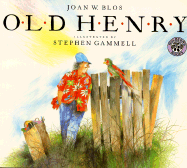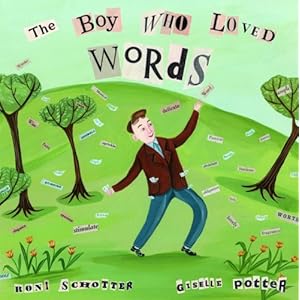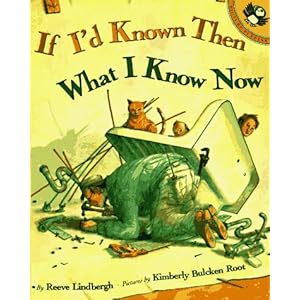Picture Books to Use for Teacher Trainings
Gathered by Shari Daniels
So, I'm a day late! (Some would say, "What else is new?")
With teacher trainings this week, and my priority being teachers, I put all my energy into planning my trainings and being present with teachers. So, today was totally devoted to getting my list of books to all! Because it's not the 11th, I had to re-title my post. . . and add an extra book (which was NOT a problem!).
This was so hard. . . narrowing down my picture books to only 10 that I am most passionate about! I love all my books for different reasons and it was hard to let some sit on my pile and not be included. (I know secretly, they were felt sad and rejected. I promised them, I would choose them as soon as possible to take into the rooms of children.)
So, I decided I would need to focus my selections on a catagory. Being I teach teachers and realize the intense importance of modeling interactive read alouds for teachers, I made a decision to choose my favorite picture books for teacher trainings. Each of these books fit a particular time of the year targeted at a specific topic of our study or dependent on the teacher moral at the given time (keep the change curve in mind).
Picture Book #1
Teaching Themes or Purposes: Develop a vision or goal, follow the kids - not the path everyone else is following (the book?), pay attention to the signs (the kids), we all get lost along the way and that's when we need to ask for help
The North Star is one of my first read alouds to new teacher training groups. It's story parallels a teacher's story of trying to adapt to change. . . this being the new teacher that has just completed college and is adjusting to many life changes, as well as the teacher who has taught the same way for 20 years, or any of us that are just going through change.
"A sweet breeze met the boy as he awoke to his journey, " are the new ideas that have awakened the teacher to embark upon the new path. In the story, the boy notices others hurrying and speeding by him, and fears being left behind. An even worse feeling was that others were ahead of him.
The forest of which he travels through grows thicker and he struggles more and more with each step, until darkness closes in around him. (Can you just not see us teachers in February hitting this point?)
He eventully steps off the beaten path that all others have chosen and finds himself lost. A bird finds him and says, "Ask yourself where it is you want to go and then follow the signs you already know."
We tell ourselves, as teachers, we need a vision, a goal in mind before we start teaching. . . or we can end up anywhere. However, this book can be used to stress the fact that we don't ALL need to follow the same path, that we look for the signs (our student observations) to know where to go, and that if we do not pay attention, we'll just be plain old lost.
Picture Book #2
The Toy Boat by Randall de Seve
Illustrated by Loren Long
Teaching Themes or Purposes: Gradual release of responsibility model, scaffolding
This book is perfect when to teach the gradual release of responsibility as a teaching and learning model.
A little boat was safe and happy as he was held close to shore by a string his little boy owner never let go of. However, the boat wondered what it would be like to sail free in the big ocean.
One day, a storm causes the string to drop from the little boy's hand and the boat floats out into the water through storms and high waves, almost getting run over by other boats and feels hopelessly frustrated and lost. A little fishing boat spots him days later and guides the little boat, modeling how to turn and sail with control.
Suddenly, the little boat was on his own, sailing with confidence!
The little boat finds the little boy again and enjoys his companion, but every once in awhile, sails back out to sea, because he can.
Picture Book #3
Old Henry by Joan W. Blos
Teaching Themes or Purposes: Community, compromising, self-reflection

That Henry. He moves into a rickety, old house that his neighbors expect him to fix up, but he doesn't. Instead he goes about doing his own thing ignoring the fact that his neighbors like a tidy neighborhood.
They even offer to help, but Henry refuses. Finally, Henry leaves frustrated that he will never change just because his neighbors want him to be neat and tidy.
Once far away from his neighbors, he begins to miss them. He realizes they were trying to only help, even offering him pie, that he refused. Likewise, the neighbors missed his presence. Both sides felt remorse for their behavior.
This book is read when we are learning about reflection, not only for our teaching, but for working with other colleagues. It's easy to take sides, point fingers and refuse help. Looking in the mirror at ourselves rather than looking out the window at others is a tough concept for us. None the less, without reflection, there is little growth, professionally and personally.
Picture Book #4
Wilfrid Gordon McDonald Partridge by Mem Fox
Teaching Theme or Purposes: Writing Ideas(objects spark memories), schema, writing about what matters

This is such a powerful book for so many reasons. I honestly don't even think I even need to give a summary, because it's one that I'm positive you have on your shelves already and have read many times.
It's wonderful to first use it to show how objects spark memories for writing. After reading this story, we always do some writing. I pull objects out of my duffle bag; antlers, a child's mitten, a screwdriver, golf ball, thread, a deck of cards and even a flashlight. Teachers write from these objects, and my, the stories that were lost, but found are a hoot to retell as we spend time sharing! All teachers leave, knowing they will have an "Writing Ideas Basket" filled with various objects for students to draw from when they are stuck.
This book can also be used to talk about schema. Each character has different interpretations of what "warm" means, based upon their past experience. The same is true for "golden" or even what a "memory" is. All children come to us with different experiences and we need to know that their schema is what we need to connect to to help them understand and learn.
Of course, this book can also be use for writer's craft, author study or the power of bringing young and old together. Possibilities are endless for this one.
Picture Book #5
The Boy Who Loved Words by Roni Schotter
Illustrated by Giselle Potter (I love her work!)
Teaching Theme or Purposes: Writers notebooks, vocabulary, passion and purpose, poetry, word choice, sharing ideas

This is a story about a boy who loved words and collected them relentlessly. He is looked down upon by friends and family and called an oddball. In a dream, a Genie encourages him to find a purpose, as he has this passion of words, but what to do with it, the boy knows not. He discovers that his purpose is to share his words with others. By doing so, others find happiness, creating happiness in the boy.
I was first drawn to this book by the artwork of Giselle Potter, one of my favorite illustrators. I am also a "word collector" myself, intrigued by words, in fact the title could be about me, except it would have to say, The Girl Who Loved Words. :-)
I use this book when I am training on vocabulary. The importance of modeling for our students our love of words is so important if we want them to care about vocabulary. Our goal should be teaching students to be curious in interesting words, collect them for later use in writing and poetry or just ponder on them, trying to determine their meaning through context clues and word parts.
I also feel this book is useful for helping teachers understand passion and purpose. Not only do we need this as teachers, but our students need this to be learners.
Picture Book #6
Yonder Mountain as told by Robert H. Bushyhead
Written by Kay Thorpe Bannon
Illustrated by Kristina Rodanas
Teaching Theme or Purposes: Leadership, lesson story

A Cherokee folktale about an elder who is no longer able to lead his people. Seeking out a new leader, he tests 3 of his strongest young men by telling them to go to a yonder mountain, climb to the top and bring back what they find there.
The first, along the way, is distracted by beautiful stones that sparkle. He immediately brings this back to the elder, knowing that trading these stones for food would make their lives better.
The second went farther than the first, yet upon resting, noticed herbs, roots and bark that were healing plants. He brings these to the elder in hopes of ending suffering.
The third makes it back to the tribe on the seventh day after a long wait by worrying people. He had nothing in his hands. However, he makes the trek all the way to the top of the mountain like he is told and has a story to tell.
From the mountain top, he witnesses smoke signals that send a message that says they need help because they are dying. He tells the elder that they need to go to them quickly, as they are in trouble.
This young man is granted the leadership position, as he has climbed to the top of the mountain, seen beyond it and to other people in need.
This is a story about what it takes to be a leader. In our schools, leaders are not those who find the best lessons to make our lives easier, or those who feed us, or those who give us things. They are those that notice when others need help because they have been there themselves. They are those who have sacrificed the distractions for the hardship of reaching their goals and then later, help others to reach their goals.
Picture Book #7
Everybody Needs A Rock by Byrd Taylor
Illustrated by Peter Parnail
Teaching Theme or Purposes : Special objects as reminders, voice, story structure,

I read this book to teachers in about February/March, the harshest of months in the teaching world. It's the month where we all need our friends to help us through.
After reading this book, we spent time searching for the rock that was perfect for each of us (from my own personal collection of rocks - as in MN, it's still the frozen tundra of winter). We then wrote a bit about why the rock was perfect for each and what it might symbolize for us as a reminder as it sits on our desks throughout the remainder of the school year. Wonderful conversation followed and teachers left feeling they had a new friend for support. . . their rock.
Of course, you can't read this book without talking about the voice or the structure of the book - that's a given. But for teachers at the despair dip of the change curve, they just need a rock. . . and fast.
Picture Book #8
The Perfectly Orderly House by Ellen Kindt McKenzie
Illustrated by Megan Lloyd
Teaching Theme or Purposes: Teacher planning, organization, less is more
I had to search for this book. It was not anywhere new that I could find, so mine is a very used looking copy. Doesn't matter. It's such a mind shifting book for teachers towards the end of the year that I hide it in a special spot for fear someone might take it. I use this book to teach how to plan.
It's a story about an old woman who lives in a very small house and could throw nothing away. She discovers she can not find anything she needs, and because of all the time she spends searching, she never has time for fun, like having a party. Of course, we all see ourselves in this as soon as it's read, and teachers are all nodding and smiling as if to say, "Welcome to my world."
So, the old woman decides to organize everything in her house by the alphabet: aprons in the attic, bowls in the basement, the cat goes in the closet and so on. She then realizes her house is not big enough, so she beckons her brother to add on more rooms.
Once the house is finished and organized, a party is planned and friends are invited. Her friends are in awe of her 26 room house, which even included a zoo! However once it was time eat, they had to search for supplies. Cookies were in the closet, ice cream in the igloo, and appetizers in the attic. The old woman was exhausted by the end of the party and wants nothing more than rest. She walks to her brothers small, perfectly orderly house and decides to stay there. . . and leave her own perfectly orderly house as it is.
In about April or early May, when we teachers are beginning to think about the next year and how we can make it better, a training on yearly planning is usually necessary. Most of us swear that if we could only be organized, our teaching life would be better. Some of us believe we need more ideas. Still others search out that "best" lesson for hours. (I am guilty of the latter.)
The lesson from this book is that having more ideas, more lessons and more stuff is not making us more effective teachers. In fact, it may be hurting us! If we spend so much time organizing, lesson searching and making stuff, then, when do we look at our students work and decide what to teach them? The best teaching is knowing exactly what to teach at exactly the right time to exactly the right student. Fewer resources help you to KNOW your resources so that you can use them effectively when you need them.
Know your students, know what they need and know your resources. Less is always more.
Picture Book #9
This one is not a picture book, it's a poem. I wish it was a picture book.
"A Little Boy" by Helen Buckley
Teaching Theme or Purposes: creativity, process not product,
This poem was given to me by a friend in a master's class who is an early childhood teacher educator. She uses it to teach creativity in art. I cried when she read it to us. It strikes such a nerve as I know we have all done what this teacher has done. Myself, so included.
I used the poem at the end of a writing training with teachers, the other day, to conclude our two days together. My hope was for teachers to leave with this poem ringing in their minds: writing is not about the product, it's so much about the process. Of course, when I read it, I cried again. No one could speak a word.
Thank you, Kate, for giving me this poem. I cherish it and hang it right above my desk.
Picture Book #10
My Mother's Voice by Joanne Ryder
Illustrated by Peter Catalanotto
Teaching Theme or Purposes: Word Choice in writing, language, voice, writing craft, grammar, special people, love

When this book first arrived last spring, I pulled it out of the Amazon box, opened it and immediately read the first page. I hung on every word and reread that page at least 3 times.
"As morning begins, my mother calls me from darkness to light."
I stopped for a moment and just relished in those words. Our mothers call us from darkness to light. What a glorious description of what our mothers truly do.
Each page in this book describes something about the little girl's mother's voice: her laughter, her words, her singing, her voice when it is sad, worried, cheering or just saying the little girl's name.
The word choice and writer's craft in this book are overwhelming. You could study one page for an hour to talk about everything you notice Joanne Ryder did to make those words do that. And what about her idea? She chose not to write about her mother, but to go smaller yet. She wrote just about her voice.
This book is short, yet so moving and inspiring in the teaching of writing. Teachers read it and listen to it in awe.
It's also the first book I give to a teacher when they say they don't know what to do for Mother's Day. "Read this to your kids and something will happen," I say.
Finally! Picture Book #11!!!
If I'd Known Then What I know Now by Reeve Lindbergh
Illustrated by Kimberly Bulcken Root
Teaching Theme or Purpose: Reflection on the year

This is the perfect book to end the first year of literacy training with. So much learning takes place in teaching every year, but that first year is daunting. I sometimes think we feel like we've failed because of how our new understandings make us think back in disbelief that we did things like we did. We wonder how our kids even learned! (I swear they learn in spite of us.) But they do!
We constantly need to remind ourselves of how far we have come and. . . you can't know what you don't know.
